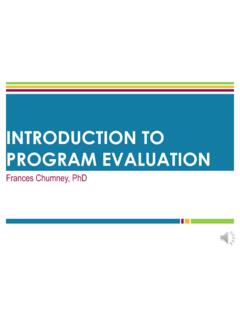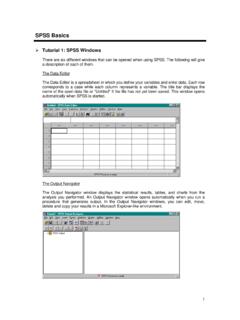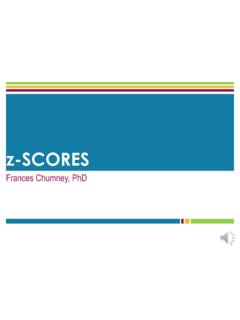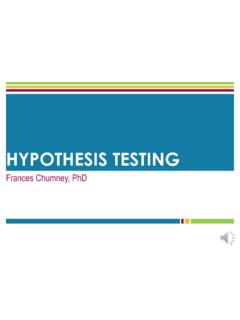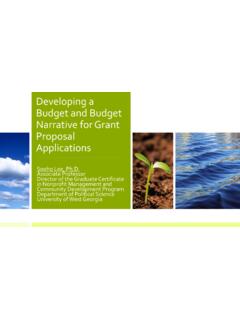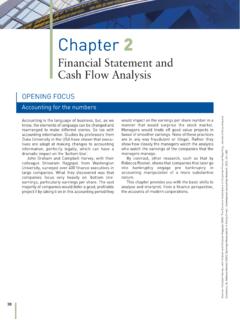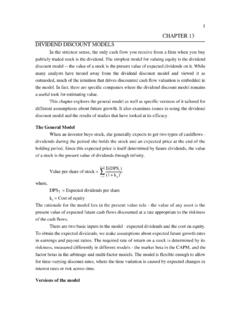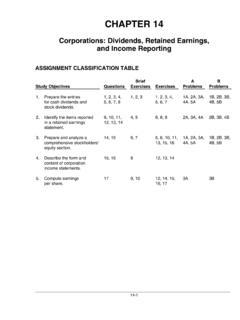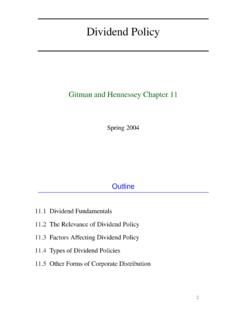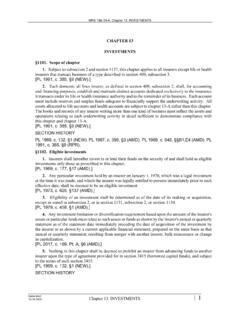Transcription of CHAPTER 14 Distributions to shareholders: Dividends and ...
1 CHAPTER 14 Distributions to shareholders : Dividends and share repurchases Theories of investor preferences Signaling effects Residual model dividend reinvestment plans Stock Dividends and stock splits Stock repurchases2 What is dividend policy ? The decision to pay out earnings versus retaining and reinvesting them. dividend policy includes High or low dividend payout? Stable or irregular Dividends ? How frequent to pay Dividends ? Announce the policy ?3Do investors prefer high or low dividend payouts? Three theories of dividend policy : dividend irrelevance: Investors don t care about payout. Bird-in-the-hand: Investors prefer a high payout. Tax preference: Investors prefer a low irrelevance theory Investors are indifferent between Dividends and retention-generated capital gains. Investors can create their own dividend policy : If they want cash, they can sell stock. If they don t want cash, they can use Dividends to buy stock.
2 Proposed by Modigliani and Miller and based on unrealistic assumptions (no taxes or brokerage costs), hence may not be true. Need an empirical test. Implication: any payout is theory Investors think Dividends are less risky than potential future capital gains, hence they like Dividends . If so, investors would value high-payout firms more highly, , a high payout would result in a high P0. Implication: set a high Preference Theory Retained earnings lead to long-term capital gains, which are taxed at lower rates than Dividends : 20% vs. up to Capital gains taxes are also deferred. This could cause investors to prefer firms with low payouts, , a high payout results in a low P0. Implication: Set a low stock price effects403020100 50% 100% PayoutStock Price ($)Bird-in-the-HandIrrelevanceTax preference8 Possible cost of equity effectsTax preferenceIrrelevanceBird-in-the-Hand302 520151050 50% 100% PayoutCost of Equity (%)9 Which theory is most correct?
3 Empirical testing has not been able to determine which theory, if any, is correct. Thus, managers use judgment when setting policy . Analysis is used, but it must be applied with Content (Signaling) Hypothesis Managers hate to cut Dividends , so they won t raise Dividends unless they think the increase is sustainable. Thus investors view dividend increases as signals of management s view of the If a company s stock price increases at the time it announces a dividend increase, this could reflect expectations for higher future EPS, not a preference for Dividends over retention and capital gains. Conversely, a dividend cut would be a signal that managers are worried about future The signaling impact constrains dividend decisions by imposing a large cost on a dividend cut and by discouraging managers from raising Dividends until they are sure about future earnings. Managers tend to raise Dividends only when they believe future earnings can comfortably support a higher dividend level and they cut Dividends only as a last s the clientele effect ?
4 Different groups of investors, or clienteles, prefer different dividend policies. Firm s past dividend policy determines its current clientele of investors. Clientele effects impede changing dividend policy . Taxes & brokerage costs hurt investors who have to switch impact might dividend policy have on agency costs? Firms with high payouts will have to go to the capital markets more frequently. Bankers will supply capital more willingly to better-managed firms. So, stockholders can worry less if the payout is is the residual dividend model ? Find the retained earnings needed for the capital budget. Pay out any leftover earnings (the residual) as Dividends . This policy minimizes flotation and equity signaling costs, hence minimizes the dividend model =budget capitalTotal ratio equity Target - IncomeNet Dividends Capital budget $800,000 Target capital structure 40% debt, 60% equity Forecasted net income $600,000 How much of the forecasted net income should be paid out as Dividends ?
5 17 Residual dividend model:Calculating Dividends paid Calculate portion of capital budget to be funded by equity. Of the $800,000 capital budget, ($800,000) = $480,000 will be funded with equity. Calculate excess or need for equity capital. With net income of $600,000, there is more than enough equity to fund the capital budget. There will be $600,000 - $480,000 = $120,000 left over to pay as Dividends . Calculate dividend payout ratio $120,000 / $600,000 = = 20%18 Residual dividend model: What if net income drops to $400,000? Rises to $800,000? If NI = $400,000 .. Dividends = $400,000 ( )($800,000) = -$80,000. Since the dividend results in a negative number, the firm must use all of its net income to fund its budget, and probably should issue equity to maintain its target capital structure. Payout = $0 / $400,000 = 0% If NI = $800,000 .. Dividends = $800,000 ( )($800,000) = $320,000. Payout = $320,000 / $800,000 = 40%19 How would a change in investment opportunities affect dividend under the residual policy ?
6 Fewer good investments would lead to smaller capital budget, hence to a higher dividend payout. More good investments would lead to a lower dividend on Residual dividend policy Advantage Minimizes new stock issues and flotation costs. Disadvantages Results in variable Dividends , sends conflicting signals, increases risk, and doesn t appeal to any specific clientele. Conclusion Consider residual policy when setting target payout, but don t follow it s a dividend reinvestment plan (DRIP) ? shareholders can automatically reinvest their Dividends in shares of the company s common stock. Get more stock than cash. There are two types of plans: Open market New stock22 Open Market Purchase Plan Dollars to be reinvested are turned over to trustee, who buys shares on the open market. Brokerage costs are reduced by volume purchases. Convenient, easy way to invest, thus useful for Stock Plan Firm issues new stock to DRIP enrollees (usually at a discount from the market price), keeps money and uses it to buy assets.
7 Firms that need new equity capital use new stock plans. Firms with no need for new equity capital use open market purchase plans. Most NYSE listed companies have a DRIP. Useful for dividend policy Forecast capital needs over a planning horizon, often 5 years. Set a target capital structure. Estimate annual equity needs. Set target payout based on the residual model. Generally, some dividend growth rate emerges. Maintain target growth rate if possible, varying capital structure somewhat if Repurchases Buying own stock back from stockholders Reasons for repurchases: As an alternative to distributing cash as Dividends . To dispose of one-time cash from an asset sale. To make a large capital structure of Repurchases Stockholders can tender or not. Helps avoid setting a high dividend that cannot be maintained. Repurchased stock can be used in takeovers or resold to raise cash as needed. Income received is capital gains rather than higher-taxed Dividends .
8 Stockholders may take as a positive signal--management thinks stock is of Repurchases May be viewed as a negative signal (firm has poor investment opportunities). IRS could impose penalties if repurchases were primarily to avoid taxes on Dividends . Selling stockholders may not be well informed, hence be treated unfairly. Firm may have to bid up price to complete purchase, thus paying too much for its own Dividends vs. Stock splits Stock dividend : Firm issues new shares in lieu of paying a cash dividend . If 10%, get 10 shares for each 100 shares owned. Stock split: Firm increases the number of shares outstanding, say 2:1. Sends shareholders more Both stock Dividends and stock splits increase the number of shares outstanding, so the pie is divided into smaller pieces. Unless the stock dividend or split conveys information, or is accompanied by another event like higher Dividends , the stock price falls so as to keep each investor s wealth unchanged.
9 But splits/stock Dividends may get us to an optimal price range. Stock Dividends vs. Stock splits30 When and why should a firm consider splitting its stock? There s a widespread belief that the optimal price range for stocks is $20 to $80. Stock splits can be used to keep the price in this optimal range. Stock splits generally occur when management is confident, so are interpreted as positive signals. On average, stocks tend to outperform the market in the year following a split.


